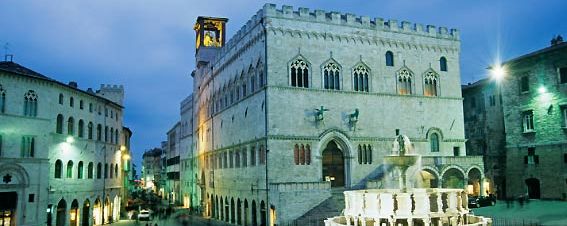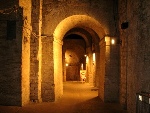
Rocca Paolina
 Rocca Paolina is a fortitude of the city of Perugia.
In 1540, during the pontificate of the Farnese Pope Paul III, Perugia was last free city in Italy and was finally defeated in what
is known as the Salt War. As a sign of the renewed papal dominion, the Pope commisioned Antonio da Sangallo the Younger to build
an imposing fortress, this time on the city's other hill:Colle Landone. The entire district of Borgo San Giuliano was rased to the
ground to make way for the fortress, including all the houses of the Baglioni family that the Pope so hated.
Over a hundred houses, as well as churches and monasteries were destroyed and used as building material and as substructures for the fortress.
This time the citizens of Perugia had to wait until the Roman Republic of 1848 for a first, partial demolition of the loathed symbol of papal
power and finally until 1860 with the unification of Italy for its final destruction.
Rocca Paolina is a fortitude of the city of Perugia.
In 1540, during the pontificate of the Farnese Pope Paul III, Perugia was last free city in Italy and was finally defeated in what
is known as the Salt War. As a sign of the renewed papal dominion, the Pope commisioned Antonio da Sangallo the Younger to build
an imposing fortress, this time on the city's other hill:Colle Landone. The entire district of Borgo San Giuliano was rased to the
ground to make way for the fortress, including all the houses of the Baglioni family that the Pope so hated.
Over a hundred houses, as well as churches and monasteries were destroyed and used as building material and as substructures for the fortress.
This time the citizens of Perugia had to wait until the Roman Republic of 1848 for a first, partial demolition of the loathed symbol of papal
power and finally until 1860 with the unification of Italy for its final destruction.
 Externally, the only visible parts of the fortress are the substructure walls along Viale Indipendenza and the eastern bastion in Via Marzia,
which incorporates the Etruscan Porta Marzia. From here it is possible to enter the foundations of the fortress, which rested on vault structures placed over the houses and streets such as Via Baglioni
The stone houses, with their Gothic doorways, are still clearly distinguishable from the brick-wall foundations added by Sangallo.
Externally, the only visible parts of the fortress are the substructure walls along Viale Indipendenza and the eastern bastion in Via Marzia,
which incorporates the Etruscan Porta Marzia. From here it is possible to enter the foundations of the fortress, which rested on vault structures placed over the houses and streets such as Via Baglioni
The stone houses, with their Gothic doorways, are still clearly distinguishable from the brick-wall foundations added by Sangallo.
Another very atmospheric route through the fortress is along the escalators that lead from the underground parking of Piazza Partigiani,
through the Rocca Paolina, under the portico of Palazzo del Governo (1870, seat of the Province), and into Piazza Italia.
 Here one is surrounded by buildings that were erected after the demolition of the fortress, such as the Albergo Brufani (1880), the Banca dItalia (1871), Palazzo Cesaroni (1897, now seat of the Regional Council Hall) and the Condominio Residenziale (the first residential joint-ownership building in Perugia, 1872), both these were designed by Guglielmo Calderini, from Perugia, who also designed the Palace of Justice in Rome.
Here one is surrounded by buildings that were erected after the demolition of the fortress, such as the Albergo Brufani (1880), the Banca dItalia (1871), Palazzo Cesaroni (1897, now seat of the Regional Council Hall) and the Condominio Residenziale (the first residential joint-ownership building in Perugia, 1872), both these were designed by Guglielmo Calderini, from Perugia, who also designed the Palace of Justice in Rome.
 The square is completed by the already existing Albergo La Rosetta and Palazzo Donini (1716-24, seat of the Regional Council ),
which contains magnificent frescoes.
The square is completed by the already existing Albergo La Rosetta and Palazzo Donini (1716-24, seat of the Regional Council ),
which contains magnificent frescoes.
Behind Palazzo del Governo, from the Carducci terraced gardensbuilt on remains of the fortress, there is a magnificent view over the surrounding area.
The poet Giosuč Carducci composed his well-known poem "Canto damore" here in 1877.
Address
Rocca Paolina
Piazza Italia [old town centre]
Perugia, 06122
Info: Ph. +39 0755728440
Infopoint Perugia Cittą Museo:
Info-line 199 194 114
APM (Public municipal bus transport authority):
stopped bus - Piazza Italia [only 50 meters away]
Linea 4, 6, 7, 9, 10, 11, 12, 13s, 13d, 15, 81, 82, 83, 87, bis28, bis33, bis34, bis41, bis44
Disabled access available
